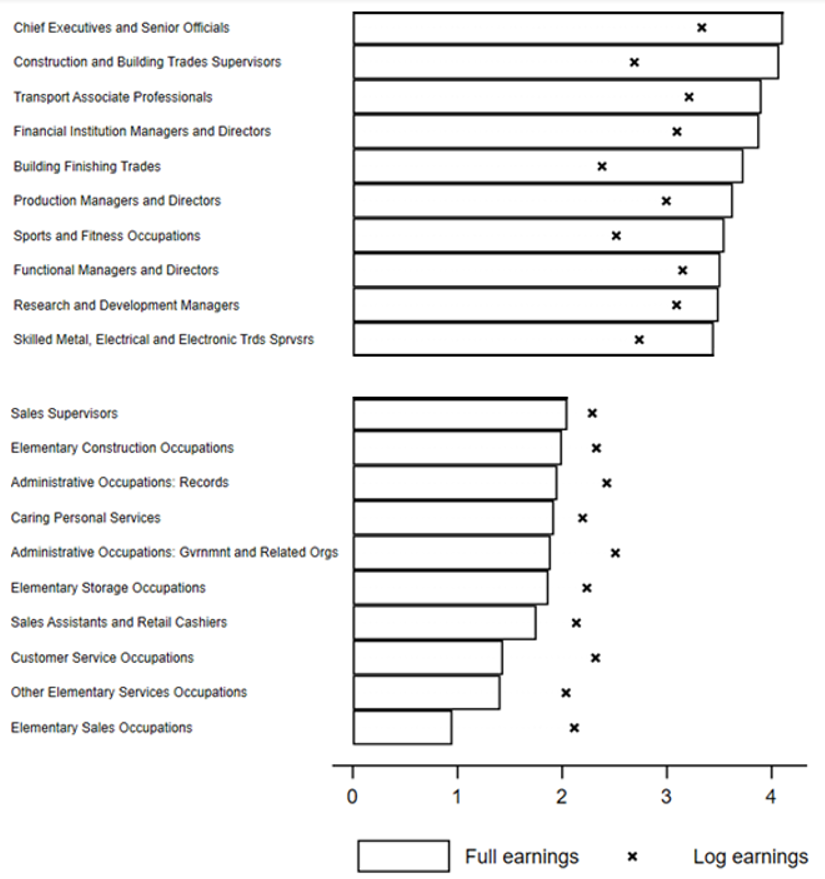While many researchers, policy makers, and interest groups are concerned with income inequality and its impact on society, much of the debate has focused on inequality in wages. In contrast, relatively little work has addressed the job rewards that are not monetary. But, as Andrew Clark, Maria Cotofan, and Richard Layard write, we need to look beyond wages to fully capture labour market inequality.
Economists have long been concerned with the way in which people are rewarded for their work, and how these rewards are distributed across individuals. A large body of work in economics has focused on how wages are determined, and the inequality that results. But while wages are important, there is abundant evidence that people also care deeply about the non-financial aspects of their work.
According to a recent survey, nine out of 10 American professionals were willing to trade part of their lifetime income in return for more meaningful work. And the Covid-19 pandemic has also highlighted the importance of these non-monetary benefits – such as, for example, the ability to work remotely. As such, the labour-market inequality experienced by workers during the current pandemic has not been limited to only monetary outcomes.
We have discovered that monetary and non-monetary rewards tend to be positively correlated – on average, those that were paid more also had better non-monetary rewards and those with lower earnings also had worse non-monetary benefits – meaning inequality in working life is greater than income data alone reveals. Many governments around the world have, to some extent, guaranteed workers’ incomes. The furlough scheme in the UK is just one example of such interventions. But non-monetary aspects of work, like the ability to work productively from home, are also likely to have played a major role in workers’ well-being. Training opportunities, good management relations, a healthy work environment and many other aspects will matter too.
So how can we paint a complete picture of the labour-market inequality? One point has become increasingly clear: we need to look beyond wages to fully capture it. But while wages are comparatively easy to measure, accurately gauging the contribution of non-monetary aspects of a job is far more challenging. First, many of the non-monetary aspects of jobs that workers find important do not appear in standard data sources. Second, we have no clear way of knowing how important these different non-monetary aspects are to workers.
Our research proposes a solution to these two problems. Using data on the subjective wellbeing of employees in the UK, we directly observe the life satisfaction of individuals in different kinds of jobs. Holding their income constant, the differences in life satisfaction across occupations reveal the value that employees assign to their occupation’s various non-monetary characteristics. Using data on employee well-being in this way, we can construct a measure of “Full Earnings”, which captures both wages and the value that each worker puts on the non-monetary rewards in their job. It is this measure of “Full Earnings” we use to quantify labour-market inequality in the UK.
We find, perhaps unsurprisingly, that the value of non-monetary rewards differs sharply from one occupation to another. But notably, these non-monetary rewards tend to be higher in better-paid occupations: we calculate that UK labour-market inequality in full earnings is one-third higher than the inequality arising from differences in wages alone. This is a substantial gap that cannot and should not be ignored. These differences in non-monetary benefits across occupations hold even when we compare employees with similar education, and when we calculate them only on individuals who are observed to change from one occupation to another. This latter shows that the differences across occupations cannot simply be explained by people with certain characteristics sorting into certain jobs.
More worryingly still, the labour market in the UK is even more unequal when we focus on groups with lower average earnings. For example, women and members of ethnic minority groups tend to have worse non-monetary rewards from their jobs on top of lower earnings.
The correlation between wages and non-monetary job aspects is positive: those in some of the best-paid jobs – such as chief executives, managers, and directors – also enjoy some of the best non-monetary rewards (or amenities) at work. On the other hand, those in low-paid occupations – such as customer service or retail cashiers – often have full earnings that are even lower than their wages alone would suggest. However, this correlation is far from perfect: some construction and industry workers have higher full earnings once the value of amenities is considered. The figure above illustrates this pattern, from top to bottom, for the 10 occupations with the highest and the 10 occupations with the lowest full earnings in the UK.
Figure 1. Earnings and full earnings in different occupations

Source: Annual Population Survey. Notes: Full earnings, which are the sum of hourly earnings and the monetary value of the non-pecuniary amenities in that occupation, are represented by the horizontal bars; hourly earnings are represented by the black crosses. The gap between hourly and full earnings measures the monetary value of amenities in that occupation. A black cross that is to the right of the bar indicates a below average value of amenities in that occupation. For example, the black crosses indicate that, on average, those working in “Sports and Fitness Occupations” earn about as much as workers in “Administrative Occupations in Government and Related Organisations”. The bars show that the full earnings of people in Sports and Fitness occupations are higher that the full earnings of people in Administrative Occupations in Government because they have better amenities.
Not all individuals are equally likely to work in each occupation. Educational attainment plays a large part in determining career trajectories and the jobs in which people end up. Even within the same occupation, the better-educated will likely have different roles and responsibilities, different access to amenities, and different earnings. So how important is a degree and what is its pay-off in terms of work benefits? We know that the better-educated earn more on average; our research underlines that they also enjoy better amenities overall.
But even so, it is important to have a good match between education and occupation. Those with university degrees experience the best amenities in managerial and professional occupations, while the lower-educated people actually enjoy better amenities than those with degrees in lower-ranked administrative occupations. As those with degrees also have a broader spectrum of jobs to choose from, they also experience a much larger dispersion in non-wage benefits. So even though degrees pay-off on average, with higher wages and higher benefits for the higher educated, they are also riskier in this sense. In other words, as amenities are identified through the life satisfaction of respondents in each job (once income has been controlled for), young graduates who end up in jobs for which they are over-qualified have worse amenities than if they did not have a degree. This raises important questions about how to best match people to jobs, and who suffers more when this matching is imperfect.
In the context of worries about rising inequalities, our findings paint a stark picture: UK labour-market inequality is significantly higher than wages only suggest, and there is no evidence overall that higher wages serve to compensate workers for their poor amenities at work. Our UK conclusions are repeated in an analysis of US workers, so that this phenomenon is not UK-specific. Policymakers who wish to narrow the gaps in labour-market outcomes should start looking more closely into the role of non-monetary aspects of work. The difficulties in measuring non-wage benefits across occupations have likely hindered progress in the past, but data on subjective wellbeing can serve to evaluate the extent of overall labour-market inequality.
♣♣♣
Notes:
- This blog post is based on The true returns to the choice of occupation and education, CEPDP1746, LSE’s Centre for Economic Performance (CEP).
- The post gives the views of its authors, not the position of LSE Business Review or the London School of Economics.
- Featured image by Ga on Unsplash
- When you leave a comment, you’re agreeing to our Comment Policy






Great research, it is time to start beyond just salary to give a fair reflection of how a job will affect your life.